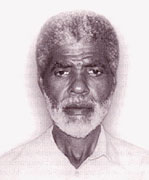Originally printed in the March - April 2002 issue of Quest magazine.
Citation: Zaney, Isaac K. "Watching the World Pass By." Quest 90.2 (MARCH - APRIL 2002):64-65.
By Isaac K. Zaney
America's Statue of Liberty
HIGH UP IN NEW YORK HARBOR there stands the statue of a lady with a radiating crown of light, bearing a torch. The statue, originally named "Liberty Enlightening the World," is now called simply the Statue of Liberty, and the torch she carries is the torch of liberty. The statue represents the ideal and the aspiration that the nation born more than two and a quarter centuries ago in 1776 stands for. In days when ships were the means for crossing the ocean, New York Harbor was the principal gateway into what was in fact an ancient world but had become to its new settlers the "new world." In 1956, the statue's site on a torch Island was renamed Liberty Island, and in July 1986, the Statue of Liberty was refurbished.
HPB'S Figure of Lucifer
The figure of the Statue of Liberty recalls that other figure which H. P. Blavatsky used on the cover of her magazine, Lucifer. It is the figure of a youth holding aloft a torch that sheds light in a surrounding gloom. That figure was meant to represent Lucifer, whose name means "the Light-Bearer." That was HPB's symbol of the Theosophical Society, holding aloft the light of the Ancient Wisdom, newly reborn into the modern world, which had been bereft or at any rate unaware of that Wisdom. HPB was herself an embodiment of that allegorical figure of Lucifer.
The association of the Theosophical Light-Bearer with America's Light-Bearer of Liberty is not without some significance. The Theosophical Society was born, doubtless not by accident, in New York, under the shadow of the Statue of Liberty. Theosophy could in fact only be born and thrive in an atmosphere of freedom—freedom to think and to be what one truly is. It was only after its birth, appropriately in the "new world," that the Theosophical Society was headquartered in India, the ancient seat of the Ancient Wisdom. From that moment, the Ancient Wisdom has flowed from its ancient Custodians in the heart of Asia, across the bridge of the Society into the young world—a world vibrant with youthful energy, which, however, needs to be guided by the wisdom of the ancients.
Fraternity and Equality
There is another association also. The Statue of Liberty, under the shadow of which the Theosophical Society was born, was a gift, a little more than a century and a quarter ago, from the people of France to the New World—from France, which holds dear the triple ideals of Liberty, Fraternity, and Equality. These also are the fundamental principles of the Theosophical Society, which proclaims the Universal Brotherhood of Humanity without distinction of race, creed, sex, caste, or color, and declares freedom of thought as a necessary environment for the growth of the human spirit.
Today this ideal—the oneness of humanity and the essential equality of its individual members—has generally been accepted in principle by the world's great leaders as the only bridge over which the present world can pass from its present crisis into a new age, characterized by that global peace which is enshrined in the charter of the United Nations as the fervent hope and aspiration of mankind—which organization is also headquartered in New York.
Realizing Brotherhood in Action
Today, the hope for brotherhood and peace seems incapable of attainment in the midst of the increased conflict all over the world. But this phenomenon of conflict is surely the desperate fight of the Dark Powers, and there is no uncertainty as to the victory soon of the Powers of the Light. Conflict and war are the signs of a dying age, unwilling to die. In this situation the work that the Theosophical Society sets itself as its first object is a most urgent one. While the world is burning around us we should not sit Nero-like playing on harps. Many organizations and individuals are carrying out various schemes and programs that have the effect of bringing about, in practical terms, the realization of the oneness of humanity, while we talk so much about Brotherhood as an ideal.
The Brotherhood of Humanity, which is our first object, can be brought into realization in the face of human tragedy by individual practical acts that demonstrate an awareness of our unity and awaken it in the hearts of other human beings. There is hunger around us, devastating tragedies occur daily around us, millions of victims of war and ethnic conflict flee from their homes and become refugees in other countries. Sensitive and compassionate hearts, awake to the oneness of humanity and to the call of brotherhood, answer by giving aid in various forms. HPB said in The Key to Theosophy: "The Theosophical ideas of charity mean personal exertion for others; personal mercy and kindness; personal interest in the welfare of others who suffer, personal sympathy, forethought and assistance in their troubles and needs."
Isaac K. Zaney of Ghana is a longtime member of the Theosophical Society who served for ten years(1973—1983) as Organizing Secretary of the Theosophical Society in West Africa. He is now Regionary Bishop for the Liberal Catholic Church in Ghana and teaches courses in Yoga and mysticism.

